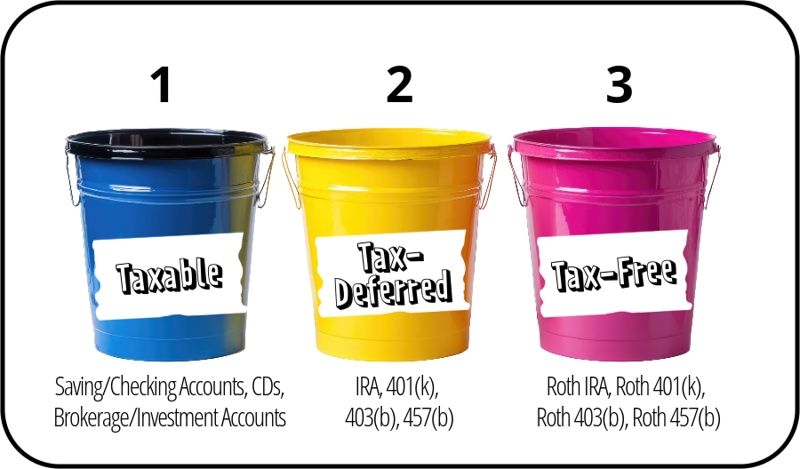
Have you heard of a Roth Conversion? If you’ve spent time on social media lately—especially following financial advisors or retirement planning influencers (be careful there!)—you’ve probably heard the term “Roth Conversion” more than once. It’s becoming a buzz phrase in personal finance, and for good reason. But understanding how a Roth Conversion works—and whether it’s right for you—could save you tens of thousands of dollars in taxes over your lifetime.

So, what is a Roth Conversion?
- Taxable Bucket (Brokerage or Bank Accounts)
Think of this as your everyday investment account or bank account. You paid taxes on this account before you or your employer deposited your paycheck. If you choose to keep it in your bank account and earn interest, you will pay taxes on the interest earned. Or if you decide to put it in a brokerage account, you will pay capital gains tax rates on the earnings. - Tax-Deferred Bucket (Traditional IRA, 401(k), 403(b), etc.)
These accounts let you defer taxes on income. You contribute pre-tax money (or deduct your contribution), and funds grow tax-deferred until retirement. But when you withdraw from it, you pay income tax on everything—contributions and earnings.
Pro: Lowers your taxable income today.
Con: Big tax bill and required distributions later. - Tax-Free Bucket (Roth IRA)
The Roth IRA is the holy grail of retirement accounts. You contribute after-tax dollars to the account, and the money grows completely tax-free, and qualified withdrawals are tax-free, too.
So, what is a Roth Conversion? Simply put, a Roth Conversion involves transferring money from Bucket 2 into Bucket 3. The catch? You’ll have to pay income taxes on the amount you transfer. But the benefit can be and usually is significant: once the money is in a Roth IRA, it grows tax-free, and you won’t owe taxes when you withdraw it in retirement.
How do you know if a Roth Conversion makes sense for you? The answer depends on your age, income level, current and estimated future tax brackets, market predictions, and overall goals. Although this maneuver considers many factors, one thing is clear: for many people, the years between retirement and the age at which Required Minimum Distributions (RMDs) out of your IRA begin—typically age 73 (or 75 if birth year after 1960)—present a golden window of opportunity.
Let’s get nerdy and break it down further. Most people save for retirement in their employer’s retirement plan (e.g., 401(k)). These are typically set up where you contribute pre-tax dollars, lowering your taxable income now and allowing you to enjoy current tax savings, but you’ll owe income tax when you take the money out later. For many, this seems like a good deal. However, many people don’t understand the long-term consequences. Once the money is in this deferred part of your 401(k), it will grow and grow. All this growth becomes taxable later. Thankfully, many employer plans are now offering Roth 401(k) options! Take advantage of this if you’re still working!
A Roth Conversion allows you to move money from a Traditional IRA into a Roth IRA. Sure, you’ll pay ordinary income tax on the amount you convert, but from that point on, the money grows tax-free. That is HUGE!
Why Consider a Roth Conversion?
You might be wondering: Why would I voluntarily choose to pay taxes now rather than later?
The answer lies in savvy tax planning. The idea is to pay taxes over a few years, hopefully at a lower rate, rather than allowing the account to grow and further increasing the amount of money you will pay in taxes down the road.
Main Advantages of a Roth Conversion:
- Tax-Free Growth: Once your funds are in a Roth IRA, they grow tax-free for the rest of your life—and even beyond.
- No RMDs: Traditional IRAs require you to start withdrawing money at age 73 or 75, whether you need it or not. Roth IRAs do not have RMDs during your lifetime.
When Is the Best Time for a Roth Conversion?
One of the most critical factors in deciding when to do a Roth Conversion is timing. The sweet spot for many people is after they retire but before RMDs begin.
Let’s explore why this period is so crucial:
- Retirement Brings Lower Income
After you retire, your earned income often drops significantly—sometimes to as low as zero—especially if you’re not yet claiming Social Security or pension benefits. This temporary dip in income could place you in a lower tax bracket, making it an ideal time to convert traditional retirement funds at a lower tax rate. - RMDs Can Push You Into a Higher Tax Bracket
Remember the JG Wentworth saying—“It’s my money and I need it now,”? Similarly, when it comes to RMDs, it’s like the IRS is saying—it’s your money and you have to take it now—by mandating you withdraw a portion of your Traditional IRA annually, whether you want to or not. These forced distributions (aka, Required Minimum Distributions or RMDs) can inflate your income, potentially pushing you into a higher tax bracket and even affecting the taxation of your Social Security benefits and Medicare premiums. By doing a Roth Conversion before your RMDs kick in, you can lower the balance in your Traditional IRA and reduce future RMDs, giving you more control over your tax situation in your 70s, 80s, and beyond. - Market Conditions and Investment Performance
If the market is down, your retirement account balance may be temporarily lower. Converting during a market dip means you’re paying taxes on a smaller amount—and when the market rebounds, the gains occur inside the Roth, tax-free.
Who Should Consider a Roth Conversion?
A Roth Conversion might be most beneficial for individuals who:
- Expect to be in a higher tax bracket later in life or in retirement.
- Have retired early and have several years before RMDs start.
- Don’t need to tap into their retirement accounts for immediate living expenses.
However, a Roth conversion might not be ideal if:
- You are already receiving RMDs.
- You need the money from your IRA soon and can’t afford to leave it growing.
- Don’t anticipate needing money from your IRA, EVER.
- Plan to give A LOT of money to charity. You can do tax-free charity gifts from IRAs after age 70 ½.
How Much Should You Convert?
That is a profound question that you should discuss with your financial planner after they evaluate your income, investments, goals, and other relevant factors. You don’t have to convert your entire IRA all at once. In fact, partial Roth Conversions, spread over several years, are often the best move. By converting smaller amounts, you can avoid pushing yourself into a higher tax bracket in any one year. Many people choose to convert just enough each year to stay within their current tax bracket. It’s generally best to convert only the money you anticipate using. And if you’re planning on leaving any money to charity upon your passing, you will usually want to leave it out of your IRA, rather than your brokerage or Roth, since your loved ones will pay income taxes upon these withdrawals, while a charity will not.
Planning Ahead & Final Thoughts
Roth Conversions are a complex financial planning strategy. It’s wise to enlist the careful guidance of a financial professional who understands your income, accounts, and financial goals to determine if it makes sense for your specific situation. A Roth Conversion isn’t right for everyone—but for many people, particularly retirees with several low-income years before RMDs start, it can be a highly effective way to save on taxes over the long term. For more information or help with your where your financial journey is taking you, talk with one of the Financial Advisors from Covenant Trust.